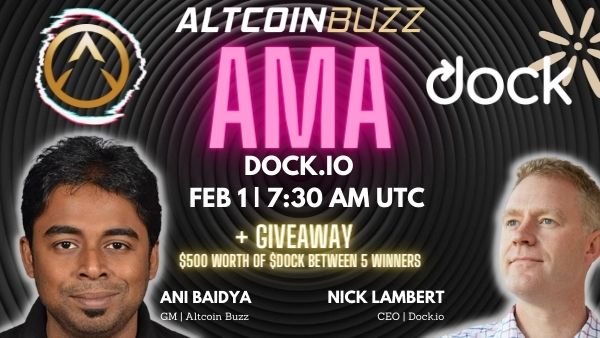Dock provides a simple solution for developers to create and manage digital credentials that are verifiable via blockchain technology.
The General Manager of Altcoin Buzz, Anindya (Ani) Baidya, anchored the Dock AMA session on our Telegram channel with Nick Lambert, the CEO of Dock.
Below is a recap of the AMA session with Nick Lambert to understand what the platform is about. Also, the AMA is in three segments: introduction, deep dive, and community questions and answers.
Segment 1: Introduction to Dock
Background Information
Q – How was the concept of Dock.io created?
Dock solves some of the basic issues that currently exist with data, where large corporations control it. Their goal is to monetize our data, which is siloed and not transferable between platforms. Also, information can be inaccurate, not verifiable, and is easy to forge. We think that there is a lack of control and privacy for users, the true owners of data.
Moreover, Dock seeks to solve these issues by combining several technologies including cryptography, a custom blockchain, and mobile application to ensure that data issued on Dock can be trusted and is easy for third parties to verify. This data can be anything from a passport proving our identity and citizenship, a graduation diploma proving our education, or a vocational license proving our ability to work in a designated field.
Q – Tell us a bit about your team. Where is the team based out of?
Dock.io is a team of 14 members with a wide range of skills, from blockchain engineers to full-stack developers, designers, marketing, support, and project managers. The company is headquartered in Switzerland but the team is entirely remote, currently based across 11 different countries.
Segment 2: Deep Dive
More Information About the Project
Q – You have already talked about the current market problem. How do you solve such problems?
We’re providing a way for individuals and organizations to create their own identities, that only they control, and then associate credentials with these identities. As mentioned, these credentials can be anything from a passport proving our identity and citizenship, a graduation diploma proving our education, or a vocational license proving our ability to work in a designated field or country.
This is what we do in simplistic terms, the tech behind it is a little more complex but we try to make this as easy to use as possible.
Q – So what phase of development are you currently in? Tell us about what you have achieved so far.
We are now in full commercialization mode and are currently focused heavily on growing adoption. We are already starting to see traction in specific industries and I’ll discuss these partnerships in more detail shortly. These are several milestones that we have achieved in recent times:
- Mainnet launch
- Token swap (from Ethereum to our chain)
- Network upgrade to Proof of Stake (from proof of authority)
- Integration of smart contract capability
- Release of API – makes it easier for developers to use Dock as it abstracts away a lot of the complexity
- Mobile wallet available in Google Play and Apple App store
So the team has been amazing at delivering their milestones.
Q – When you talk about your chain, is it an independent chain? I know you are working with Polkadot.
It is an independent chain. It was built using Substrate which is a framework created by the team at Parity – so we are part of the Polkadot ecosystem but have our group of validators.
Therefore, we originally built Dock on Ethereum, but it was becoming increasingly congested and expensive, which made Dock unviable so we needed to build our chain.
Q – In the future, are you planning to participate in Kusama/ Polkadot parachain auctions?
Good question. Not at the moment, this is a new area and we continue to watch the space to see how it develops. At the moment, Dock operates its network of validators as I mentioned.
Q – How can third-party developers get involved in the project and be rewarded for doing so?
Yes, that is correct, Dock has already started to build our apps including our mobile wallet and also a node code identity and credential platform called Dock Certs – people can sign up and check that out here.
And yes 3rd party developers can get involved. We recently (last week) launched a Developer Program that enables them to choose a task, submit an application to Dock, and receive a reward once the project is completed. Also, they can propose their own task/project and if it benefits the ecosystem, Dock will fund it.
Dock's Developer Program
All applications will be reviewed by the Dock team and ones that fall within the guidelines and meet the objectives will be rewarded the grant to begin their project.
Apply for #Dock's developer program here https://t.co/TvSXO883lR
— Dock (@docknetwork) January 27, 2022
Q – I quickly registered to Dock Certs. It’s a good platform with various options. I can create my own DID. Is it still under Testing? Will the data later be live then?
This is at the alpha stage and is linked to our test network, but all the functionality is there and very soon users will be able to add these to the main chain. Soon, users will be able to store credentials created on Dock Certs on their mobile device which will be cool. So they can store ID docs and credentials along with their DOCK tokens.
Decentralized Identities (DIDs) and #VerifiableCredenetials (VCs) are a new type of unique identifier with linked verifiable information that can be controlled solely by the user.
Find out how your organization can benefit from Dock's API here https://t.co/2CXVHCbrJI
— Dock (@docknetwork) January 31, 2022
Q – Let’s talk a bit about this platform. Any user can create a Decentralized Identifier (DID). Once created, how do I use this? Can you give us two use cases?
A user creates their identity which they control completely and provides their public address to their University. As the individual completes their studies the University issues their degree certificate to them. They store the certificate in their digital wallet and can send this to whoever they choose. If they apply for a job they can send it electronically to their prospective employer who can verify the degree is genuine by checking the digital signatures. The certificate can also be optionally added on-chain providing a timestamp of when the certificate was issued.
Another example, one that many of us will have seen in the press, is health passports or Covid passports.
Vaccination history can be issued to a user’s identity in the form of a verifiable credential, again stored in a user’s wallet, and they can present this to anyone they choose to confirm their vaccination status.
Q – What is the use-case of the Dock Token?
There are three main utilities for DOCK:
- Governance – token holders can actively participate in submitting proposals, voting, and electing council members.
- Network operations – You can pay for transactions with Dock tokens. Also, you can create DIDs, anchor and revoke credentials, and send payments.
- Staking and validating – Validators get rewards for validating, and those rewards are shared with nominators who support them.
Q – Tell us about your future roadmap
We’ve got a really exciting few months ahead of us with a lot of milestones and partnership announcements planned. We can’t talk too much about the partnerships just yet, but the milestones include:
- Wallet SDK – enables other apps to integrate Dock wallet features
- No code solution for credentials – called Dock Certs
- An Ethereum bridge – more on this soon
- Ledger wallet support
- Credential wallet storage – current version supports Dock tokens only
- Release of web wallet
- Staking via mobile and web wallet
- Traceable credentials
Segment 3: Community Questions and Answers
For this segment, the five best questions shared $500 worth of $DOCK. Here are the questions:
Q.Twitter – DOCK reminds me of KYC systems. So, are DOCK’s services different from what we know as KYC methods nowadays? What makes it different from KYC? Also, just for pure curiosity can DOCK work as a KYC system if that’s what a company wants from it?
Yes, it can. It can work with existing KYC systems and make them much better for everyone. So a user can go through an identity verification check if they are signing up for a new exchange account, for example. But they have to do this every time they go to a new exchange.
But, users can create re-usable KYC with verifiable credentials. So in the future, a user could go through an identity verification to check and be sent a credential token that states they have passed through KYC. This credential can then be re-used with exchange number 2 and exchange number 3 as their identity verification check, where exchanges trust the original ID verifier.
This means the user need only go through this process once, and for exchanges 2 and 3 the onboarding time is much faster and there is way less friction.
Q.Twitter – Can I be sure that when I revoke a DID, this data will be confidential and not be seen by third parties?
Good question. So we don’t advocate putting personal data on-chain, all that goes on-chain is the DID and a hash of the credential if it is anchored. The user’s wallet is normally the place where credentials are.
Anything that is on-chain of course is public and no one can delete it, as it is immutable like all blockchains. The revocation just stops the individual from being able to present that credential as valid to a third party. I hope that makes sense.
Also, join us on Telegram to receive free trading signals.
Find out more about the blockchain and crypto space on the Altcoin Buzz YouTube channel.
Disclaimer
The information discussed by Altcoin Buzz is not financial advice. This is for educational, entertainment, and informational purposes only. Any information or strategies are thoughts and opinions relevant to the accepted levels of risk tolerance of the writer/reviewers and their risk tolerance may be different than yours. We are not responsible for any losses that you may incur as a result of any investments directly or indirectly related to the information provided. Bitcoin and other cryptocurrencies are high-risk investments so please do your due diligence. This article has been sponsored by Dock.io. Copyright Altcoin Buzz Pte Ltd.




























